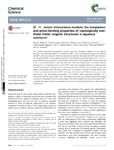Mostrar o rexistro simple do ítem
[C–H⋯anion] interactions mediate the templation and anion binding properties of topologically non-trivial metal–organic structures in aqueous solutions
| dc.contributor.author | Bilbeisi, Rana A. | |
| dc.contributor.author | Prakasam, Thirumurugan | |
| dc.contributor.author | Lusi, Matteo | |
| dc.contributor.author | El-Khoury, Roberto | |
| dc.contributor.author | Platas-Iglesias, Carlos | |
| dc.contributor.author | Charbonnière, Loïc J. | |
| dc.contributor.author | Olsen, John-Carl | |
| dc.contributor.author | Elhabiri, Mourad | |
| dc.contributor.author | Trabolsi, Ali | |
| dc.date.accessioned | 2019-10-30T11:23:36Z | |
| dc.date.available | 2019-10-30T11:23:36Z | |
| dc.date.issued | 2016-02-12 | |
| dc.identifier.citation | R. A. Bilbeisi, T. Prakasam, M. Lusi, R. El Khoury, C. Platas-Iglesias, L. J. Charbonnière, J. C. Olsen, M. Elhabiri and A. Trabolsi, Chem. Sci., 2016, 7, 2524–2531. | es_ES |
| dc.identifier.issn | 2041-6539 | |
| dc.identifier.uri | http://hdl.handle.net/2183/24221 | |
| dc.description.abstract | [Abstract] Two synthetic approaches—temperature variation and anion templation—allowed for the selective formation of a [2]catenane ([2]C4+) or a trefoil knot (TK6+), or for the enhanced formation of a Solomon link (SL8+), all from a simple set of starting materials (Zn(II) acetate, diformylpyridine (DFP) and a diamino-2,2′-bipyridine (DAB)) in mixed aqueous solutions. The catenane formed exclusively at 90 °C in a 1 : 1 mixed solvent of D2O and MeOD. In the presence of bromide ion as template, TK6+ formed exclusively at 50 °C in the same solvent. In the solid state, TK6+ hosts two bromide ions in its central cavity by forming six Csp2–H hydrogen bonds. In D2O, TK6+, which was originally prepared as a trifluoroacetate (TFA) salt, was found to exchange two TFA counterions for two monovalent anions of different sizes and shapes, which lodged within the knot's central cavity. In contrast to bromide, the larger triflate anion (CF3SO3−) promoted the formation of SL8+, which was characterized by 1H NMR spectroscopy and mass spectrometry. Two dimensional heteronuclear 19F-1H-HOSEY NMR experiments detected CH⋯F interactions inside the cavity of SL8+. Thus, the product distribution of this dynamic link forming system is sensitive to temperature and the size and shape of the anion template, and one of the products, TK6+, is capable of binding a variety of monovalent anions in D2O with high affinity (with log β2 values of 4 to 6 being typical). | es_ES |
| dc.language.iso | eng | es_ES |
| dc.publisher | Royal Society of Chemistry | es_ES |
| dc.relation.uri | https://doi.org/10.1039/c5sc04246a | es_ES |
| dc.rights | Atribución 3.0 España | es_ES |
| dc.rights.uri | http://creativecommons.org/licenses/by/3.0/es/ | * |
| dc.subject | Anion binding | es_ES |
| dc.subject | Knots | es_ES |
| dc.subject | Zinc | es_ES |
| dc.subject | Hydrogen bonds | es_ES |
| dc.subject | Template | es_ES |
| dc.title | [C–H⋯anion] interactions mediate the templation and anion binding properties of topologically non-trivial metal–organic structures in aqueous solutions | es_ES |
| dc.type | info:eu-repo/semantics/article | es_ES |
| dc.rights.access | info:eu-repo/semantics/openAccess | es_ES |
| UDC.journalTitle | Chemical Science | es_ES |
| UDC.volume | 7 | es_ES |
| UDC.issue | 4 | es_ES |
| UDC.startPage | 2524 | es_ES |
| UDC.endPage | 2531 | es_ES |
Ficheiros no ítem
Este ítem aparece na(s) seguinte(s) colección(s)
-
GI-REACT! - Artigos [103]






